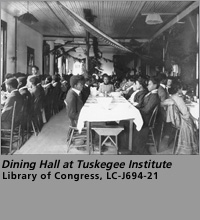 |
 |
 |

   

   
 |
 |

Students were taught, in addition to their academic subjects, skills in building construction, brick making, woodworking, cooking, handicraft, agriculture, and the blacksmith trade. Student life was regulated and controlled by separating activities and training for men and women. Physical training was encouraged. The Tuskegee doctrine of work required a healthy body. Tuskegee also recognized the moral and spiritual value of religious worship. Students attended daily non-denominational chapel services.
Female students learned home economics, dressmaking and weaving. They made brooms, rugs, hats, chairs, baskets, and soap. For many years, the products of this practical training dressed the students and furnished Tuskegee rooms.
Student teachers did practice teaching at the Children's House. Built in 1901, it was the elementary school for children of teachers and townspeople. Children learned gardening and farming on the two acres around the house. Students were also taught the basics of proper housework, including cooking and gardening.
 Bricklaying, a practical, productive skill, was taught. The Tuskegee brickyard produced enough bricks to sell the surplus to the community and provide the school with an income. Brick making, begun in 1883 was not an instant success. Only after ruining many bricks did the novice brick makers finally master the craft. Tuskegee students used brick fired from clay dug on the Tuskegee farm to erect many of the Bricklaying, a practical, productive skill, was taught. The Tuskegee brickyard produced enough bricks to sell the surplus to the community and provide the school with an income. Brick making, begun in 1883 was not an instant success. Only after ruining many bricks did the novice brick makers finally master the craft. Tuskegee students used brick fired from clay dug on the Tuskegee farm to erect many of the
school's buildings.
 A broad range of mechanical industries were taught, including electrical engineering, carpentry woodworking, roofing, and printing. The print shop served two purposes. It provided training for students and supplied the school with needed products. A broad range of mechanical industries were taught, including electrical engineering, carpentry woodworking, roofing, and printing. The print shop served two purposes. It provided training for students and supplied the school with needed products.
< Previous Next >
|
 |
 |



























































